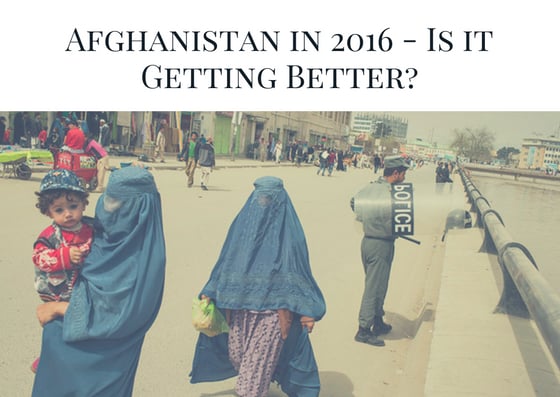Afghanistan in 2016

There is no doubt that Afghanistan remains a very poor country with significant internal problems. It is unlikely to receive many casual visitors in the foreseeable future, indeed travel within the country is still heavily restricted. Kabul has hotels which cater to the foreign traveler, as well as some attractions. Kabul province is the only one in the country which has a greater urban than rural population. According to the UN, more than 70% of the population still lives in rural areas.
The Taliban were ousted in 2001 and Afghanistan has been a constitutional republic for more than ten years now. There are still insurgencies associated with extreme Islamic groups.
Education
In 2001, girls did not attend school by decree of the Taliban, and there were only about one million boys in education.By 2012, according to the World Bank, there were 7.8 children attending school, including 2.9 million girls. Girls’ dropout rates are still very high in secondary schools. The adult literacy rate of just 39% is one of the lowest in the world, but with recent developments in education this number is slowly increasing.
Although there are now more of them, many schools still operate from tents, houses and even under trees. The World Bank states that of 180,000 teachers, only 52% meet minimum required standards. Many of the others are however receiving in-service training.
The Position of Women
Under the Taliban, not only were girls forbidden from attending school, but also women were forbidden from going out to work.
Afghan women get married young and typically have five children on average. According to the CIA World Factbook, the country has the 10th highest birth rate in the world. In 2007, 52 percent of Afghan women were married by the age of 20. Literacy rates amongst women are still low and Unicef figures suggested a rate of just 22% in 2011. This said, an increasing number of women are beginning to embark upon careers for themselves. More than a quarter of government employees are now women and they are being employed by the government at a faster rate than men. Women are now also employed by the police and the army. British officers helped to establish a military academy which aims to train 100 female army officers each year.
In spite of these advances, violence against women is still a problem. Beatings, forced marriage and withdrawal of economic support are still prevalent. It is difficult to change traditional attitudes and women are sometime forcibly prevented from participating in social activities.
Poverty
Afghanistan is a landlocked, mountainous, traditional country with poor infrastructure and communications. It remains a very poor country despite encouraging recent steps forward. The percentage of people in Afghanistan considered to be living below the poverty line is 36%. This ranges from 29% in urban areas to 36% in rural areas and 52% amongst the country’s nomadic population. Afghanistan also has a large refugee problem. More than six million people returned after the Taliban were displaced and the government estimates that up to a third of them still need support.
In 2010, Afghanistan had the lowest gross national income per head of population in the whole of Asia. In 2008 the unemployment rate was estimated at 35%. Only 5.5% of the population has access to the internet but there has been a recent surge in the number of mobile phone owners.
Health
There have been positive advances in health care over the past decade. Average life expectancy has increased from 56 to 60 and there have been significant decreases in the infant and maternal mortality rates. According to the UN, access to safe drinking water has improved and reached 60.8% in 2011. Access to proper sanitation has also advanced but much more so in urban than rural areas.
Economy
Unfortunately Afghanistan’s biggest export is still opium. Although efforts have been made to persuade farmers to diversify, the country still produces 90%of the world’s opium. Other exports include fruit and nuts, hand woven carpets and wool. Imports include machinery, food, textiles and petroleum products.
Apparently Afghanistan has rich natural resources including natural gas, but this has yet to be exploited because of the political instability. It has a very low rate of energy use – one of the lowest in the world just 28% of the population (mostly urban dwellers) is connected to the national power grid and the service is unreliable.
This then is a snapshot of modern Afghanistan. It is a country which has had more than its share of upheaval and has still many problems. But life is slowly improving and the hope is that the advances continue to be maintained and the people can live with a lasting peace.
